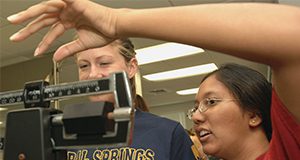
Being physically active is fun, has many physical and mental health benefits, and can help maintain a healthy weight. The Physical Activity Guidelines for Americans recommend that adults be purposefully active for at least 150 minutes per week for overall health and wellness. One proven strategy to make sure you reach your activity goal is to track your energy expenditure. This three-page fact sheet explains the different free and low cost cell phone apps, websites, and portable devices available for tracking physical activity. Written by Madison K. Keesling and Anne E. Mathews and published by the Food Science and Human Nutrition Department.
http://edis.ifas.ufl.edu/fs283
Tag: Anne Mathews
Body Fat and Health: How Can I Tell if I am at Risk for Health Problems?
Obesity is called an epidemic because there is a high rate of obesity in the United States. In fact, over 30% of all US adults were obese as of 2012, and more than two-thirds are either overweight or obese. This is concerning because excess body fat is linked to poor health and chronic diseases, such as diabetes and heart disease. The amount of excess body fat a person has is commonly sorted into weight status categories using Body Mass Index. This three-page fact sheet describes the body mass index and how to calculate it. Written by Kohrine A. Counts and Anne E. Mathews and published by the Food Science and Human Nutrition Department.
http://edis.ifas.ufl.edu/fs284
Understanding Dietary Supplements
More than half of adults in the United States take at least one dietary supplement. It is important to know in what situations supplements may be effective for improving health and wellness. This three-page fact sheet describes dietary supplements, when to use them, and how to evaluate their safety and efficacy. Written by Daniel Staub and Anne Mathews and published by the Food Science and Human Nutrition Department.
http://edis.ifas.ufl.edu/fs278
El sobrepeso y el mantenimiento de la perdida de peso (FSHN1304S/FS228)
 Para muchas personas, la pérdida de peso es una batalla crónica. Las dietas populares a menudo son poco exitosas porque no se pueden seguir de forma permanente. No hay una dieta mágica que le pueda hacer bajar de peso inmediatamente, pero a continuación se enumeran algunos buenos consejos para la pérdida de peso de una manera estable y de largo plazo. This 3-page fact sheet was written by Anne Mathews, Lauren Foster, and Wendy Dahl, and published by the UF Department of Food Science and Human Nutrition, April 2013.
Para muchas personas, la pérdida de peso es una batalla crónica. Las dietas populares a menudo son poco exitosas porque no se pueden seguir de forma permanente. No hay una dieta mágica que le pueda hacer bajar de peso inmediatamente, pero a continuación se enumeran algunos buenos consejos para la pérdida de peso de una manera estable y de largo plazo. This 3-page fact sheet was written by Anne Mathews, Lauren Foster, and Wendy Dahl, and published by the UF Department of Food Science and Human Nutrition, April 2013.
http://edis.ifas.ufl.edu/fs228

